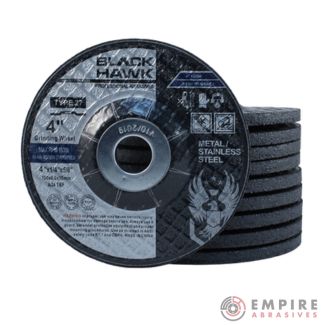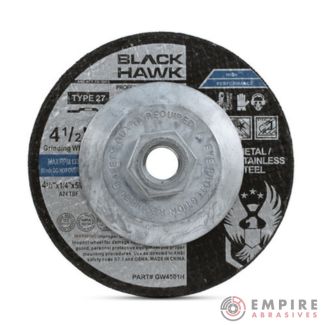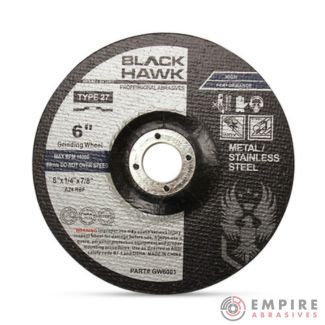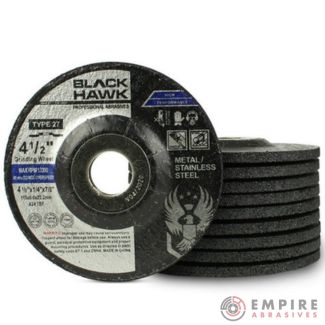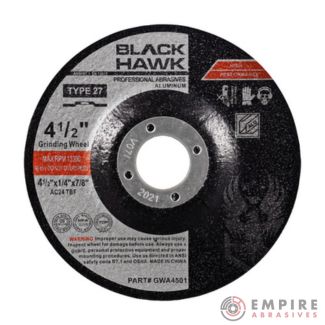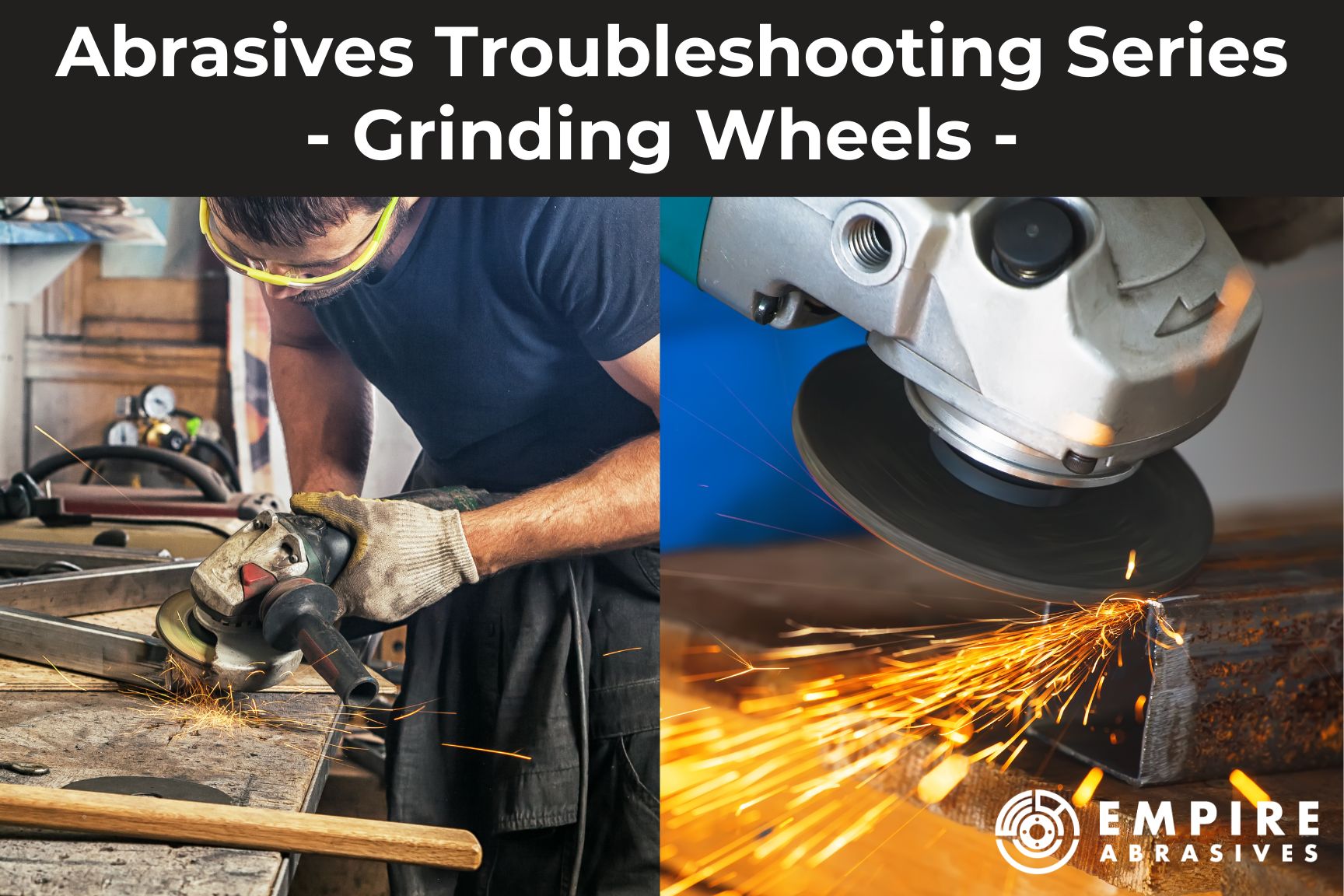
Grinding wheels have become a mainstay in various industries, such as manufacturing, metal fabrication, construction, and automotive repair. They serve as vital tools for shaping, cutting, and smoothing materials.
While versatile and efficient, they can present some common issues if not handled and maintained correctly. This article provides a comprehensive look at the grinding wheels for angle grinders, the problems they may encounter, and tips to keep them performing at their best.
About Grinding Wheels for Angle Grinders
Grinding wheels for angle grinders are specialized bonded abrasive discs used to grind, cut, and shape various substances such as metal, concrete, ceramics, or glass.
Types of Grinding Wheels
Various grinding discs are designed for different purposes, depending on the material and task.
Some of the most common types include:
- Straight Grinding Wheels: Used for cylindrical, centerless, and surface grinding.
- Grinding/Cutting Wheels: Thinner discs that can be used for either grinding or for cutting materials into parts.
- Depressed Center Grinding Wheels: These are used for smoothing and finishing surfaces, mainly metal.
Applications
Grinding wheels for angle grinders can be found across many sectors, offering versatile solutions for professionals and DIY enthusiasts alike:
- Manufacturing: Shaping and finishing parts, removing burrs and excess material.
- Construction: Cutting concrete, tiles, and other building materials.
- Automotive: Repairing and maintaining vehicles, especially in bodywork.
- Home Improvement: Assisting in tasks such as sharpening tools or grinding rough edges.
Maintenance and Angle Grinder Tips
Ensuring that the grinding wheels function optimally requires careful maintenance and attention:
- Proper Installation: Ensure the wheel is correctly mounted on the angle grinder.
- Regular Inspection: Checking for cracks, wear, and other Grinding Wheel Problems that may lead to failure.
- Appropriate Usage: Using the proper grinding disc for the task and operating it at the correct speed.
- Cleaning and Storage: After use, the wheels should be cleaned of debris and stored correctly to avoid damage.
Whether dealing with Abrasive Tool Issues or seeking to enhance performance, a proper understanding of these wheels will serve both professionals and DIY enthusiasts in achieving their objectives efficiently and safely.
Common Grinding Wheels Issues

Grinding wheels designed for angle grinder use are susceptible to various problems affecting their performance. Understanding these issues and how to troubleshoot them is vital for maintaining the efficiency and longevity of the wheels.
Wheel Wear
Wheel wear refers to the gradual erosion of the grinding wheel's abrasive surface. This problem can lead to reduced cutting efficiency, poor surface finish, and potential safety risks.
Causes of wheel wear
- Improper Usage: Using the wheel for tasks it's not designed for. For example, using a grinding wheel designed for metals on extremely hard materials like ceramics or gemstones could accelerate wheel wear.
- Excessive Pressure: Applying too much force during grinding.
- Incorrect Speed: Operating the wheel at speeds higher or lower than recommended.
- Poor Quality Materials: Using wheels made from substandard abrasive materials. It's essential to choose grinding wheels made from high-quality materials to ensure longevity and efficiency. At Empire Abrasives, we pride ourselves on crafting our grinding discs from top-tier abrasive materials, ensuring our customers get the most out of every disc.
Troubleshooting and prevention tips for wheel wear
- Choose the Right Wheel: Select the appropriate wheel for the material and grinding operation.
- Monitor Pressure: Maintain consistent and appropriate pressure during grinding.
- Follow Manufacturer Guidelines: Operate the wheel at recommended speeds.
- Regular Inspection: Check for signs of wear and replace worn wheels as needed.
Glazing
Glazing occurs when the wheel's abrasive surface becomes smooth and glossy, reducing its grinding ability. It can result in prolonged grinding times and an uneven finish on the material.
Causes of glazing
- Insufficient Aggression: Using a wheel with a bond that's too hard for the material.
- Wrong Wheel Selection: Choosing a wheel unsuitable for the specific grinding operation.
- Improper Speed: Running the wheel at incorrect speeds.
Troubleshooting and prevention tips for glazing
- Choose the Right Wheel Bond: Match the hardness of the wheel's bond to the material being ground.
- Adjust Speed: Follow the manufacturer's recommendations for operating speeds.
- Regular Dressing: Regularly dress the wheel to maintain its abrasive quality.
What is Wheel Dressing?
Dressing a grinding wheel is a process done to renew the wheel's surface and restore its original grinding properties. This is done by removing the clogged and worn-out abrasive grains, revealing a fresh layer of grains. Dressing makes sure the wheel remains sharp and free from contaminants, allowing for efficient grinding.
Loading
Loading refers to clogging the wheel's surface with the material being ground. It can cause overheating, vibration, and loss of accuracy in the grinding process.
Causes of loading
- Wrong Wheel Type: Using a wheel not designed for the specific material.
- Incorrect Speeds: Operating the wheel at speeds that encourage material buildup.
- Inadequate Coolant: Lack of proper lubrication during grinding.
Troubleshooting and prevention tips for loading
- Use Suitable Grinding Wheels: Select wheels specifically designed for processing material.
- Control Speed: Adjust the wheel speed according to the material and operation.
- Ensure Proper Lubrication: Apply appropriate coolant to prevent material from sticking to the wheel.
Wheel Breakage
Wheel breakage is a severe problem that can lead to both tool damage and personal injury. Broken wheels can shatter without warning, creating significant safety hazards.
Causes of wheel breakage
- Overloading: Applying too much force during grinding.
- Incorrect Mounting: Fitting the wheel improperly on the grinder.
- Damaged Wheels: Using wheels with cracks or other visible damage.
- Improper Storage: Storing wheels in a manner that leads to weakening over time.
Troubleshooting and prevention tips for wheel breakage
- Use Appropriate Force: Don't overload the wheel with pressure.
- Mount Correctly: Ensure that the wheel is mounted according to manufacturer instructions.
- Inspect Before Use: Check for visible damage before using and store correctly.
- Follow Safety Protocols: Use safety guards and follow proper safety procedures.
Inefficient Grinding
Inefficient grinding leads to slow material removal and prolonged job completion times. This issue affects productivity and can cause frustration.
Causes of inefficient grinding
- Dull Wheel Surface: The wheel's abrasive surface has become dull.
- Wrong Wheel Type: The wheel isn't suitable for the specific grinding application.
- Incorrect Speed: Running the wheel at inappropriate speeds for the material.
Troubleshooting and prevention tips for inefficient grinding
- Regular Dressing: Dress the wheel to keep its surface sharp.
- Select the Correct Wheel: Use a wheel that matches the material and grinding task.
- Follow Manufacturer Speed Guidelines: Use the recommended speeds for the wheel and material.
Excessive Noise or Vibration
Excessive noise or vibration during grinding can indicate underlying problems. It affects both operator comfort and the quality of the grinding finish.
Causes of excessive noise or vibration
- Wheel Imbalance: The wheel isn't balanced correctly.
- Wheel Damage: Cracks or other structural issues in the wheel.
- Machine Misalignment: Misalignment of the grinder's components.
Troubleshooting and prevention tips for excessive noise or vibration
- Balance the Wheel: Ensure that the wheel is properly balanced.
- Inspect for Damage: Regularly check the wheel for structural issues.
- Align the Machine: Ensure that the grinder's components are correctly aligned.
Overheating
Overheating during grinding can lead to wheel breakdown, material discoloration, and reduced tool life.
Causes of overheating
- Excessive Speed: Running the wheel at high speeds for the material.
- Insufficient Coolant: Not using enough coolant during grinding.
- Prolonged Grinding Without Rest: Continuous grinding without allowing the wheel to cool.
Troubleshooting and prevention tips for overheating
- Adjust Speed: Use appropriate speeds for the material and wheel.
- Use Adequate Coolant: Apply sufficient coolant during grinding operations.
- Allow Cooling Time: Don't continuously grind without allowing the wheel to cool down.
Uneven or Rough Finishes
Needs to be more careful or rough finishes are a common problem in grinding operations, leading to poor aesthetic quality and potential rejection of the workpiece. This can result in wasted materials and time, increasing costs and delaying project completion.
Causes of uneven or rough finishes
- Incorrect Wheel Selection: Using a wheel unsuitable for the specific grinding task.
- Improper Technique: Misalignment or incorrect angles during grinding.
- Wheel Wear: An overly worn wheel can cause uneven surfaces.
- Inadequate Coolant: Lack of sufficient coolant during grinding.
Troubleshooting and prevention tips for uneven or rough finishes
- Choose the Right Wheel: Select a grinding wheel designed for the specific task and material.
- Use Proper Technique: Align and angle the grinder correctly for smooth operation.
- Inspect and Replace Worn Wheels: Regularly check for wheel wear and replace as necessary.
- Apply Adequate Coolant: Utilize proper coolant to avoid overheating and surface irregularities.
By recognizing and addressing these common Grinding Wheel Problems, users can maintain the performance and longevity of their grinding wheels for angle grinders. This will lead to better results and less downtime, further underlining the importance of proper Grinding Wheel Maintenance and Angle Grinder Tips.
Additional Tips for Using Grinding Wheels for Angle Grinders
To further enhance the performance and longevity of grinding wheels for angle grinders, consider these other tips:
- Follow Manufacturer’s Guidelines
- Explanation: Every grinding wheel is designed with specific materials and operational limits in mind. Manufacturers provide guidelines to ensure optimal performance and safety.
- Example: If a grinding wheel is rated for a maximum speed of 6,000 RPM, operating it beyond this limit can lead to premature wear, reduced efficiency, and potential safety hazards.
- Wear Proper Safety Gear
- Explanation: Grinding operations produce dust, sparks, and can result in flying debris. Wearing the right safety gear can protect you from these hazards and potential injuries.
- Example: Always wear safety goggles to protect your eyes from sparks and debris. Additionally, using gloves can protect your hands from heat and sharp edges, while a dust mask can prevent inhalation of fine particles.
- Regular Maintenance:
- Explanation: Just like any other tool, grinding disks and angle grinders require regular maintenance to ensure they operate efficiently and safely.
- Example: After each use, clean the wheel to remove any accumulated debris. Periodically check the grinder's components, such as the motor and bearings, for signs of wear or damage.
- Store Properly:
- Explanation: Proper storage ensures the longevity of the grinding wheel and prevents any potential damage that can occur when not in use.
- Example: Store grinding wheels in a cool, dry place, away from direct sunlight and extreme temperatures. If possible, hang them on a pegboard or store them in their original packaging to prevent any contact with other tools or objects that might cause chipping or cracking.
Conclusion
Grinding wheels are indispensable tools in various industries, but they have challenges. From wheel wear to glazing, loading, and overheating, users must know potential grinding wheel problems. Understanding these issues and how to troubleshoot and prevent them is vital for achieving efficient grinding and maintaining safety.
By following the provided angle grinder tips and guidelines for grinding disc maintenance, professionals and DIY enthusiasts can ensure that their grinding tasks are completed efficiently, safely, and with the desired quality.
Whether dealing with wheel breakage or uneven finishes, this guide offers actionable insights to address the common abrasive tool issues associated with grinding wheels for angle grinders.
Abrasive Troubleshooting Guides
More from our abrasives troubleshooting series:
- Troubleshooting Common Abrasive Tool Issues - Sanding Belts
- Troubleshooting Common Abrasive Tool Issues - Cut-Off Wheels
- Troubleshooting Common Abrasive Tool Issues - Wire Brushes
- Troubleshooting Common Abrasive Tool Issues - Tungsten Carbide Burrs
- Troubleshooting Common Abrasive Tool Issues - Flap Discs

